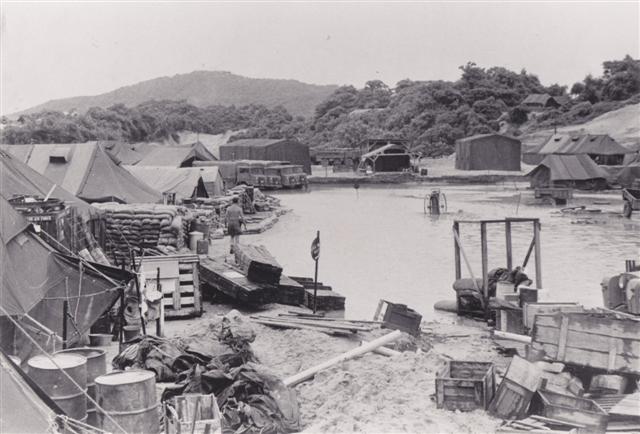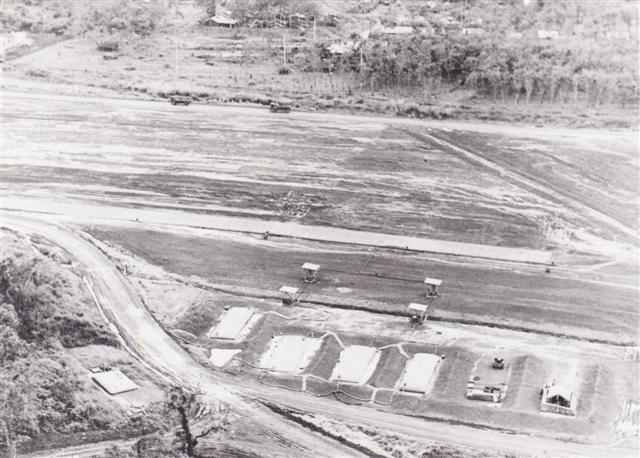Base Areas Vietnam






Logistic Support Base Vung Tau
Located at the entry port of Vung Tau, 1 ALSG was able to feed on the American infrastructure for much of its support.
1 ALSG base area, with the RAASC company on the left
In the sandhills during the wet
Vung Tau May 1966
The wet season began one month after arrival, and 1 Company's area became constantly flooded. This frequent disruption added to the pressures of establishing the force and supporting its operations.
Thousands of tons of rock were laid in the base area by the Engineers, carted by 87 Tpt Pl tippers. Also part of this fill was reputedly a quantity of missing stock buried by shifting sand.
The area was gradually improved – hard standings for vehicles and stores were established, tents progressively replaced by huts in both living and working areas, centralised messing was introduced and a range of amenities provided.
Photo: D.B. Ferguson
Task Force Maintenance Area Nui Dat
Intended as an operational base in the centre of 1 ATF's area of responsibility, it progressively grew extended into a minor logistics base in its own right, holding large stocks of ammunition, food and fuel.
Ammunition point
Nui Dat 1968
Operated by the ammunition element of 25 Sup Pl, it was more than the usual temporary holding point for immediate replacement, acting as an intermediate storage area between the US depot at Vung Tau and the Task Force.
The bays cut into the hillside of Nui Dat provided both protection from hostile fire and a reduction in normal safety distances by the shielding effect between bays.
Being divorced from the main company area and activities, the point went through a period of command neglect resulting in resupply failures, a lesson in the importance of continuous management of all the sinews of war.
Royal Australian Corps of Transport Museum
Helicopter refuelling and rearming point
Nui Dat 1969
The helicopter was a transport workhorse of the war; helicopter gunships were an integral source of fire support. RAAF Iroquois utility helicopters were augmented when unavailable or when more were needed for major troop deployments by US Army ones, and for artillery lifts by US Chinooks.
Fuel demands of all these thirsty turbine engines required bulk refuelling, so 8 Pet Pl established this beside Kangaroo Helipad, allowing simultaneous refuelling of 10 aircraft. It was also necessary to have an ammunition bay for rockets and machine gun ammunition (off picture) for simultaneous rearmament of the aircraft.
Royal Australian Corps of Transport Museum
Temporary Support Bases
Forward Task Force Maintenance Area
Long Binh 1968
Where major deployments were made beyond economical helicopter resupply distance from the task force base at Nui Dat, logistics elements – RAASC, RAAOC and RAEME plus unit echelons were set up at a convenient forward area, sometimes a fire support base, here the US depot complex at Long Binh in Bien Hoa province, supporting battalions protecting that base.
A forward element of HQ 26 Coy, as well as commanding its own transport, air dispatch, supplies, POL and ammunition elements in the area, also was the HQ TFMA, controlling the miscellany of other unit elements there, as HQ 26 Coy also did in the Nui Dat base for the parent units of all logistic services.
26th Transport Squadron
Fire Support Base Coral
Bien Hoa Province June 1968
Fire support bases were firm bases in which artillery and logistic support units were established in defensive perimeters, from which infantry and armoured units operated and received support.
Coral was set up as part of a blocking operation against a North Vietnamese division's route from the US base at Long Binh. The enemy force attacked the two-battalion Australian force, and was repulsed. In the foreground are the Task Force Maintenance Area and unit echelon areas.
The base was resupplied from Long Binh base where a forward detachment of 1 ALSG, mainly 5 Coy, was established to draw supplies, fuel and ammunition from US depots and forward them by road and helicopter to the Forward TFMA, operated by 26 Coy.
Photo: G.J. Christopherson
Base Areas Vietnam





